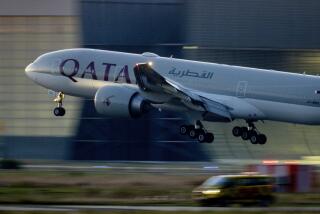Update Medical Care on Airliners
- Share via
The Air Transport Assn. reports that more than 10,000 passengers a year experience in-flight medical emergencies, underscoring the pressing need for the Federal Aviation Administration to require that flight attendants learn emergency medical techniques and that aircraft carry basic medical equipment and drugs.
Most European and several Asian airlines carry hospital-style emergency medical kits, and for years Qantas and Virgin Atlantic airlines have carried defibrillators, devices that monitor heart attack symptoms and deliver electric shocks to restore normal cardiac rhythm. U.S. requirements, incredibly, have changed little since the 1920s.
Now American and Delta have announced plans to carry expanded medical kits and defibrillators on all flights, and competitive pressures may motivate other major U.S. carriers to do the same.
But the FAA should not wait for the market to rectify this sorry situation. It should implement a uniform policy now.
Working with the American College of Emergency Physicians and the American Heart Assn., the agency should update its list of required medications and equipment to include treatments for the common in-flight medical emergencies, such as attacks of asthma, bronchitis and nausea. Flight attendants should be trained in basic emergency techniques like CPR. And Congress should extend current “good Samaritan” protections against malpractice suits to include aid rendered aboard planes. Taken together, these actions would form a sound program for in-flight medical aid.
More to Read
Sign up for The Wild
We’ll help you find the best places to hike, bike and run, as well as the perfect silent spots for meditation and yoga.
You may occasionally receive promotional content from the Los Angeles Times.






